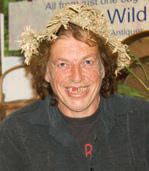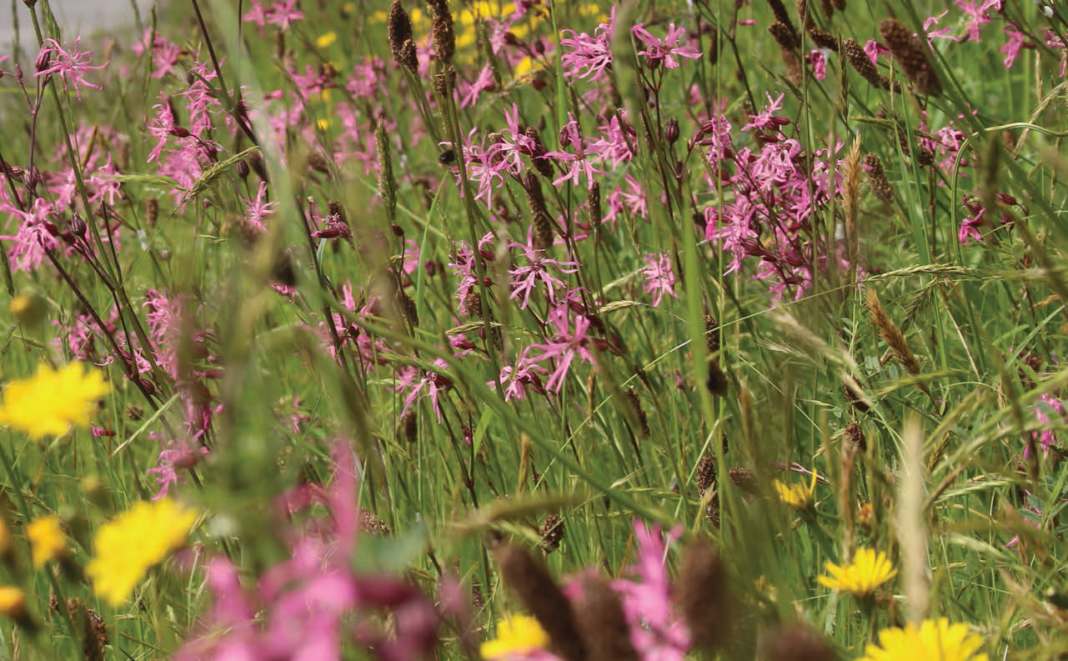Sandro Cafolla of Design by Nature dispels some myths and sets the record straight about the success of wildflower meadows in Ireland
As someone who has grown wildflower meadows for over 30 years, I have seen many successes and lots of failures. There is one certainty about establishing a meadow: if you know and understand your site and species they nearly always grow. If you take short cuts or deviate from the instructions you are effectively leaving potential success to chance. The further the divergence from what is required, the greater the difference in the results. Also, as no two sites are the same, why would any two bags be the same.
A word of caution, British, EU and American wildflower advice is for soils, climate and species very different to Ireland. Worse still is advice from quazi-landscapers, writers, journalists and seed re-packers whose interests are not yours. Over the years I have read such guff about wildflowers that I would say 50% of all failure is due to misinformation and lies. The best advice comes from full-time wildflower growers or professionals with a proven track record over many different sites, and these days there are many.
To help you make more informed decisions about what works and what doesn’t with native wildflower meadows, I’ve compiled a list of commonly held myths. If you don’t agree or have a different opinion, please contact me directly.
“50% of all failure is due to misinformation and lies”
MYTH IF YOU JUST CHUCK THE SEEDS OVER THE WALL THEY WILL GROW
Wildflower meadows took hundreds of years to evolve, they need management and maintenance, they need some site preparation.
MYTH MIX SEED WITH SAND
Sand is far heavier than seed and usually damp, meaning it sticks clumps of seed together. Instead, learn to sow just seed or use dry crushed oats mixed in to help you identify where the seed is.
MYTH YOU CAN SOW INTO GRASS
You can sow into an existing sward or you can ‘plough up’ a fresh growing sward and sow wildflowers. If you turn a grass sod over without ‘killing it off’ the grass will eventually recover and in doing so you enrich the soil and improve the grass so it out-competes the flora. Ploughing and rotavating also often bring up a buried layer of weeds, especially dock which ruins a meadow. Deep Ploughing can work well.
Also, you can’t just scatter wildflower into the grass, especially over commercial vigorous grass which is bred to out-compete the weeds and sown at such high rates there is no room for weeds to grow. One way around this is to stop feeding a sward for a few years, prior to sowing, ‘scratch harrow’ the surface. You can then establish a limited species meadow in Autumn. If you sow the semi-parasitic species such as Red Bartsia, Eyebright and Yellow Rattle whose roots absorb water and minerals from its host, they reduce the spread and vigour of meadow grasses by 50%. As parasitic species are often upright growers they cannot tolerate summer grazing or cutting below the topmost flower buds. Autumn is the best time to sow these species as winter breaks down the seed coat ready for spring. I recommend sowing the seed of these species close together in patches onto bare soil as the seedlings help each other to establish in the difficult grassy environment.
MYTH YOU NEED POOR SOIL
Poor soil produces great meadows, but rich soil can also. The Shannon Callow’s are some of the very best species-rich meadows on some of Ireland’s most fertile soils. They can survive because of late grazing and then winter flooding. Mostly the summer flowering species are taller than the surrounding grasses, so they can out-compete them. These tall species have deep roots that grow below the root zone of the grasses avoiding competition.
Gardeners know that lawns with fertile soils grow dandelion, daisy, plantain, selfheal, yarrow and buttercups, and the more these are cut, the more weeds can establish. Many of these small species spread sideways and early on smother the grass with wide broad leaves. So, the choice on fertile soil is either cut short and often or leave very tall provided there is enough species diversity of stiff plants to hold up the meadow in summer storms.
MYTH STRIP THE TOPSOIL
While stripping away topsoil will greatly help on unnatural high fertility, weedy sites or with a seed bank of unwanted weeds, you must leave a layer of friable second B-profile ‘weed root free’ soil for the seed to germinate into. Most true C-profile subsoils are very low nutrient, compact, with water running off the smeared surface that it’s difficult to even sow the seed into the soil. More so the seedlings that do grow take years to develop beyond a few leaves and in summer growth is often yellow, especially where grasses are present. After about 10 to 15 years, wildflowers will rebuild topsoil, so why strip it off? I only recommend stripping soil if the topsoil is needed elsewhere or there is no alternative.
MYTH GRASS TAKES OVER
We have all seen grasses smother a meadow. Why? Because the existing grass species are commercial vigorous strains such as ryegrass. Typically, its sown very heavily, as in the case of those UK 80% grass 20% flora mixtures designed for eastern England chalky soil where the grass dies back in hot summers. If a meadow is established with lots of annuals to check the grass in the first year and allow deep rooting perennial species to germinate under the ‘nurse crop’ then the meadow will succeed.
MYTH THEY MUST BE CUT, OR THEY DON’T NEED ANY CUTTING
Most meadows should be cut once, and everything raked up as soon as you can. Tall bird attracting meadows can be cut and cleared in early spring. Short meadows can be topped every six to eight weeks, short flora is ideal for honey bees as they need flowers.
MYTH WILDFLOWERS DON’T GROW
Far too often imported seed is stored for too long in the UK, French or Dutch warehouses and is stale. It’s then sold cheap ‘dumped’ into Ireland as we have no regulations or enforcement of the few laws that apply, unlike other countries. 70% of all imported seed is not native provenance seed. Most so-called ‘wildflower’ is commercially grown and has lost its wild ‘seed trigger’, meaning that if it doesn’t germinate at once like lettuce seed, it will not germinate over the years when conditions are best-suited, which is why true native species will grow. Far too often they grow but are not cut and managed properly, but it’s easier for the contractor to blame someone else.
MYTH WILDFLOWERS ONLY GROW FOR ONE YEAR
Most grass-free wildflower meadow mixtures contain annuals, biennials and perennials. The annuals grow first and fast and provide nurse crop conditions for all other species. In the second year, the biennials emerge which are then followed by perennials. While some perennials germinate and grow in the early stage, most take a few years. By then the customer is disillusioned as the meadow is not a ‘field of tulips’! It’s your responsibility to educate your customer that meadows evolve and take time, just likes shrubs and trees. It’s the annuals that only grow for one year, go on ask yourself why!
MYTH YOU CAN GROW A MEADOW IN SHADE
No, you can grow a flora in the shade or semi-shade, but not a meadow, most meadow plants need at least six hours midday sunshine if not full sunshine.
MYTH YOU CAN SCATTER WOODLAND SPECIES ONTO SOIL
No woodland species need soils rich in humus.
MYTH WILDFLOWERS ARE EXPENSIVE
Wildflowers cost between 15 to 36 cents per square metre for the seed and greatly reduce the management, inputs and cutting regimes so that over five years they are the lowest cost alternative to sowing grass and never cutting it.
MYTH NATIVE IS NATIVE
100% Irish origin seed has to be collected in Ireland, from Irish parent materials. It’s not that it’s native that counts, it’s that its provenance is Irish. Native seed can be native to another country and sold here as native. Ask for DAFM certification and proof that they are either wild-collected or grown in Ireland. Yes, I would say that but then again, as we are the only company in the world to guarantee our wild seed to three or five years depending, I can guarantee our mixtures because they grow, or I would not still be in business.
MYTH SANDRO’S DESIGN BY NATURE SEEDS FAIL TO GROW
Our seed is tested by DAFM and can be seen growing at our farms and for our clients all across Ireland. We have less than 2.5% failures in 30 years. Only once did we have to give a customer their money back as much of the soil on site was polluted with diesel.
Mainly our seed has failed after we sell it, and it’s out of our control, as we all know there are those in the industry who then substitute it with fillers, mix it with inappropriate grass seed, destroy it by leaving too long to drown in the hydroseeder.
Another reason why wildflowers don’t grow is that they sat in a van during hot weather and cooked. In other cases, the seed was just spread a bit here and there and you expect a full meadow. Then there are those who sow it too deeply or just onto the surface without the seed contacting the soil. The worst guff I hear from those who should know better, and it clearly identifies the industry’s lack of willingness to question where they get their info from, “when you cut it, leave the cuttings on the ground for a few days to shed the seeds”. First, flowers and seed grow all summer over a range of species and within species over long flowering periods, most seeds have already been shed, such advice only applies to July and early August cuts of a meadow. Secondly, as you cut it, more seed is shaken out and falls. And yes, a few days on the ground would help release more seed… but who can ever get a contractor back to clear up, especially a farmer with a cutting bar. So, get the whole job done at once, cut, rake up and remove the cuttings, then harrow over the surface to scratch the soil so that with the sudden onslaught of sunlight those dormant seeds can grow.
MYTH THERE ARE NO SUCCESSFUL EXAMPLES
There are many examples across the country which serve as positive examples of how following best practices yields positive results. For me, probably the best meadow we supplied seed for was Cabinteely Park under the direction of Dun Laoghaire Rathdown. They started on poor soil, cut it every year and over twenty years later it’s stunning and saved a fortune in maintenance. When it first grew, letters were sent in ‘to have it cut, it’s so unsightly!’ Years after, when the park lads cut the pathways in the meadows, the same people complained about cutting their meadow: You can’t win.
Another great success is on many Eskers for NPWS and Offaly Co Co, where we have established floras that are identical to the local native floras. In one case which really reflects excellent practice, we collected seeds from protected species nearby. Along with these, there are countless examples created by private gardeners.
If you want to establish a meadow, know your site, do your homework, use certified seed, the correct methods of sowing and maintenance, and if you have any questions, ask an expert: That’s what we’re here for. ✽
  He can be contacted through his website www.wildflowers.ie or via email at info@wildlfowers.ie |








